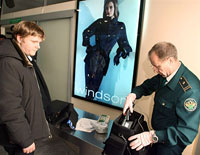Nov 2 2008
Thanks to ESA and UK technology transfer support, a British company has developed a device based on the gamma-ray detection equipment used in ESA's Integral astronomy satellite to detect and identify the radioactive material mixed with conventional explosives in 'dirty bombs'.
 Border control of radioactive materials
Border control of radioactive materials
ESA has supported the development of technology for gamma-ray astronomy for more than 40 years. Integral, ESA’s International Gamma-Ray Astrophysics Laboratory launched in 2002, is now detecting some of the most energetic radiation to be found in space, such as that from gamma-ray bursts, supernovas and black holes in the Milky Way and distant galaxies at the edge of the observable Universe.
This same technology is now being used by the company to develop and commercialise radiation detection and identification technology. The company was formed in 2002 and with support from the UK technology transfer initiative and ESA’s Technology Transfer Programme Office it was put in contact with a world-leading provider of explosives trace and X-ray detection systems.
Most radioactive sources produce gamma rays of various energies and intensities. By detecting and analysing them, a gamma-energy spectrum can be produced – a kind of radiation fingerprint – to identify the substance and the quantity.
Portable detection device
In 2006, the companies’ partnership led to a contract from the Domestic Nuclear Detection Office of the US Department of Homeland Security for a next-generation radiation gamma-ray detection and identification system. The contract has a potential total value, including options, of US$222 million (€140 million).
The detection of illicit traffic in radioactive materials that could be used to make dirty bombs is a high priority for national security in the US.
Threatening nuclear materials must be identified from a range of natural radioactive materials such as clay tiles, ceramics and even bananas, as well as from a range of legally transported radioactive materials such as medical isotopes.
Effective screening devices are required for personnel and freight at ports and borders. The detection and identification of dangerous radioactive material has to be reliable and quick so as not to disrupt the normal flow of commerce.
The companies are developing a handheld and backpack Human Portable Radiation Detection System, tailored to meet these criteria. The device features space radiation detection hardware and signal processing software for use by emergency services, border patrol agents, customs and coast guard officers, and other law enforcement personnel.
The detectors can identify and determine the location of incoming radiation and also reliably discriminate between normally occurring radioactive material and potential threats.